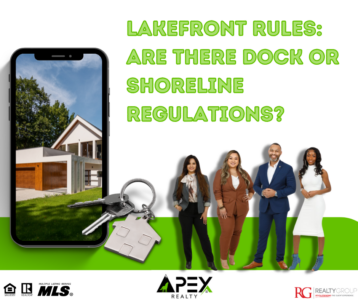
Owning a lakefront property is a dream for many Minnesota homeowners. The idea of waking up to the serene view of the water and having direct access to boating, fishing, or swimming is undeniably appealing. However, if you’re considering buying or selling a lakefront home, it’s crucial to understand the dock and shoreline regulations that come with owning waterfront property. These rules can vary significantly depending on the county, lake, or city you’re in, so being informed is key to making a smart investment.
Understanding Dock Regulations in Minnesota
In Minnesota, docks and other structures placed in public waters are regulated by the Minnesota Department of Natural Resources (DNR). The primary purpose of these rules is to ensure safety, protect aquatic habitats, and preserve public access to lakes and rivers.
Key dock regulations to keep in mind:
- Dock Size Limits: Docks must not exceed 8 feet in width, and they should be placed in a way that does not block access for neighboring properties.
- Placement Guidelines: Docks should not extend so far into the water that they interfere with navigation or public use.
- Permits: In most cases, permits aren’t required for docks under 8 feet wide. However, larger structures or docks in environmentally sensitive areas may require special permits.
- Floating Structures: Floating platforms are often allowed but must adhere to size restrictions and placement rules.
Shoreline Regulations to Protect Natural Resources
The shoreline is one of the most regulated aspects of lakefront property in Minnesota. These rules are designed to minimize erosion, protect water quality, and maintain healthy ecosystems. If you’re buying or selling a home with a shoreline, be aware of the following:
- Vegetation Alteration: Removing vegetation along the shoreline is often restricted. Natural vegetation acts as a buffer to prevent erosion and filter pollutants.
- Setback Requirements: Structures like homes, sheds, or patios must adhere to setback requirements to maintain a healthy buffer zone.
- Riprap Use: Adding rocks or riprap to stabilize your shoreline typically requires a permit. This is to ensure it won’t negatively impact the lake’s ecosystem.
- Beach Sanding: Adding sand to create a beach is heavily regulated. Permits are required, and there are strict guidelines on how much sand can be added and where.
Why Regulations Matter for Lakefront Property Owners
Understanding and following dock and shoreline regulations isn’t just about compliance; it’s about preserving the beauty and health of Minnesota’s lakes for future generations. As a lakefront property owner, you are a steward of the water and the land around it. Following these guidelines helps protect the environment, avoids fines or legal issues, and ensures that your property retains its value.
Navigating Lakefront Rules When Buying or Selling
If you’re considering buying or selling a lakefront home in Minnesota, it’s essential to work with a knowledgeable real estate agent who understands local regulations. As someone who has helped countless clients navigate the complexities of lakefront properties, I can guide you through the process, ensuring that you’re fully informed about any potential restrictions or opportunities tied to the property.
Owning lakefront property is a unique and rewarding experience, but it comes with responsibilities. By understanding dock and shoreline regulations, you’ll be better equipped to enjoy your slice of waterfront paradise while respecting the rules that keep Minnesota’s lakes pristine.
For expert guidance on buying or selling lakefront homes in Minnesota, don’t hesitate to reach out.
– Jordan Eatherton, Apex Realty Team
